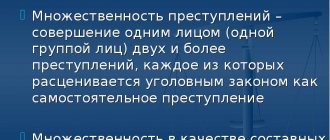Crime concept
So, the term is revealed in the following definition: an act officially prohibited by criminal law under threat of punishment, which causes harm directly to an individual, property or the state.
It can be expressed not only in action, but also in inaction.
In addition, it is possible to give the following characteristics:
- such a commission is caused by social danger. It is directly described by degree (quantitative value) and character (qualitative);
- guilt. This means that a person is guilty in a situation of committing an act through negligence or intentionally;
- illegality acts as a legal characteristic. Thus, the prohibition of what happened must strictly comply with certain rules of law. Thus, a socially dangerous action (inaction) cannot be considered as such if it is not provided for by law;
- Punishability. The severity is determined by the nature and degree. The measure that will be assigned as a result is provided exclusively by the state. Application can only come from the court.
In the absence of at least one of the above signs, the behavior of an individual that is not approved by society cannot be regarded as lawlessness. Accordingly, measures in the criminal legal sphere cannot be applied to a person who is characterized by such behavior.
Along with this, it is worth understanding that each situation is individual. So there are many factors that influence an individual study and the outcome. In this case, there may be mitigating and aggravating circumstances. If one of them is present, the choice of court may be radically different than in the absence of such a circumstance.
Examples of civil responsibility from life
Find the civil offenses on the list and write down the numbers under which they are listed.
1) citizen N. exceeded the speed limit when entering the courtyard of the house
2) citizens of R. were renovating their apartment at night
3) citizen M. was unable to return the money borrowed from citizen N. within the prescribed period
4) the store refused to accept the defective dress she purchased from the customer
5) Citizen Sh. was late for work again, citing traffic jams on the highway.
6) the publishing house released an additional edition of the book without notifying the author and without paying him a fee
Composition of a civil offense (misdemeanor):
− illegal behavior, action (inaction) that violated the rights and obligations established by the norms of civil law;
− harm in civil law that can be caused to a person (moral harm) or property (damage, losses, material harm).
Examples of civil offenses are listed under the numbers 346
1, 2 administrative offense, 5 - disciplinary offense.
Classification of crimes
The system of varieties itself is a combination of criminal cases according to one or another criterion.
Thus, depending on the type of object, encroachment can be distinguished against:
- personalities;
- public order;
- state power;
- economic spheres;
- military service.
In relation to the subject of the attack, the following are distinguished:
- implementation by female and male individuals;
- exclusively by adults;
- individuals over 14 years of age.
According to the form of guilt, intentional and careless actions are divided . This typology is considered the most important in the individualization of punishment. Consequently, this also influences the decision of choosing a correctional institution.
This criterion is used when formulating the type of relapse, the limitation period for implementation, as well as when choosing liability.
According to the duration and continuity of intentions, intentions can be classified: simple, lasting and ongoing. The initial one often occurs in one episode; that is, for a certain period. Examples include the secret seizure of someone else's property, insult, and murder. Lasting refers to an indefinite period of time. Let's say a person illegally acquires and uses weapons. The duration is determined until the offender is detained. Also, termination may occur from the moment of surrender and so on. The last type, continued, is characterized by the presence of common goals, intent, harm and focus on a single object. Let's say the production of counterfeit money.
It is possible to divide based on the level of social danger into simple, qualified and privileged.
Bernard L. Madoff...$65 billion.
Organization: Bernard L. Madoff Investment Securities LLC
When: From the 1980s until Madoff's arrest in December 2008.
How: Bernard Lawrence Madoff committed one of the largest financial crimes in history using a Ponzi scheme, defrauding thousands of (mostly wealthy) investors. Almost $65 billion, including all of the fake "winnings" from this pyramid scheme, was lost. Many investors went broke. At least two people committed suicide, including French financier René-Thierry Magon de la Villehuchet, who lost his entire life savings and $1.4 billion of his client's money. He cut his wrists with a utility knife in his Manhattan office. Madoff became known as "The Most Hated Man in New York." Mark Madoff, the swindler's eldest son, hanged himself with a dog leash two years after his father's arrest, while his own two-year-old son slept nearby.
Sentence: 150 years in prison.
Types of crimes according to the Criminal Code of the Russian Federation
Article 15 of the first part of the Criminal Code of the Russian Federation indicates the following legislative division:
- Slight heaviness. This includes both careless and intentional cases. The maximum imprisonment is three years. This type often does not threaten human life, but health may be at risk. For example, theft, fraud, as well as deliberately causing minor health damage;
- The middle category also includes cases committed due to negligence and intentional ones. For the first of these, the limit may be three years, and for the second - five years. Thus, there may be a great risk to society. This includes, like incitement to suicide, aggravated theft, and so on;
- Only those cases that were reproduced with intent are classified as serious Thus, for their execution, imprisonment for a maximum of ten years is guaranteed. Particularly serious cases include a term of over 10 years or more serious punishment. In this case, the highest stage of threat to society arises, where an attack occurs on the rights and interests of a citizen. The most common example is death.
Forms of criminal activity
Legal science identifies such forms of criminal activity as:
- Political crime.
It implies all kinds of abuses by the authorities against their own people for political purposes and criminal prosecution for secret political reasons. This also includes abuse of official position and abuse of power.
- Profitable crime. This form contains various crimes affecting market relations (fictitious financial transactions, creation of false companies, etc.). Often, modern achievements of science and technology are used here (for example, theft by infiltrating bank computer networks).
- Violent crime.
This form of criminal activity includes terrorism, premeditated murder, grievous bodily harm and violent selfish actions (for example, robbery, extortion).
- Organized crime.
It is a form of illegal activity that is carried out by entire groups of criminals monopolizing various areas.
- Crime of marginalized groups.
Crimes of this form are committed mainly by people who remain on the edge of reforms in educational, cultural, financial and other spheres of society (refugees and illegal emigrants are also included here).
- Financial crime.
It is formed in the process and due to the interaction of the state and the economy. The public danger of financial crime lies in the negative impact on social structures and in non-compliance with the established order.
- Latent crime.
This form includes crimes that remained unknown to the authorized bodies due to the criminals’ concealment of their own actions or due to the reluctance of victims and witnesses to file statements with the designated bodies.
- Juvenile delinquency.
This form of criminal activity is increasing at a rapid pace and is considered an acute state and social problem. This is due to the fact that factors such as changes in social connections, an unstable financial situation, and the lack of a clear system of national values primarily affect children.
Plurality of atrocities
A caught criminal may be charged with a single crime until he is found guilty of the others. As a result, recidivism, proven through the issuance of expert opinions and prosecutorial verification, makes a single act for each act a cumulative set. The difference between multiple crimes and single crimes is based on the identified evidence and factors that confirm that a single person committed several atrocities under different articles. They may be isolated individually, but collectively they are likely to be convicted for several cases at once, even if they occurred at different times and years.
Complicated acts
An ongoing crime is characterized by the presence of several elements that need to be checked. This raises a legitimate question: how long will each version be checked before the statute of limitations expires? In specific cases, for two out of three reasons, we can talk about complications of the investigation. When a person is seriously injured, the investigation determines whether the patient will recover or die. In the first case, the prosecutor's office is faced with one investigation, and in the second, with a number of complications.
The signs of a single crime of a continuing type can be characterized as a crime committed, which has a continuation in the form of non-cessation of the crime. This does not mean that a person who committed theft for the first time and was released with a fine can go and commit a repeat robbery. Here we are talking about a different meaning, where a single crime has quite diverse examples.
What happens in practice?
It is not always possible to make a fair decision in court, even if it can later be challenged. Sometimes they are classified into a degree of greater and more serious punishment. If there is no basis to assume otherwise, then the court is inclined to accept the opinion of the witnesses and parties who will act as plaintiffs. Sometimes in practice it is quite difficult to convince the prosecutor and the court of innocence when it comes to multiple crimes. It is unfair to apply articles under it, since for a single criminal act you can get off with a fine. That is why in a number of cases the position of the plaintiff is taken into account, who cannot or does not want to treat the defendant and the accused favorably.
What to do if isolated crimes are of a more loyal nature, and many judges believe that these are forced crimes in order to commit a crime and receive a minimum sentence? Judges often disagree, but in practice it is quite difficult to force them to understand what only a criminal is right about if he does not consider himself to be one. If justice were logical and ideal, many would be released from prison, while others worthy of punishment would spend most of their lives behind bars.









